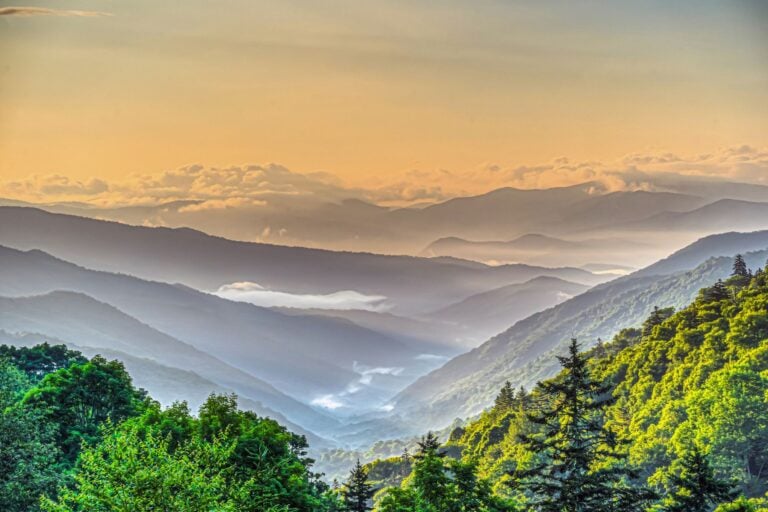
The first rays of the morning sun streaked through the clouds, highlighting the blue fog which ringed the soaring ridges and blanketed the valley floor.
We were standing, for the first time, in an expansive, lush valley surrounded by mountains in the Great Smoky Mountains National Park. Mesmerized, I allowed the emerging view to envelope me.
Kathy, my wife, and I had determined to be at the park as the sun rose. We were rewarded with that iconic look, which lingers in your mind’s eye for days afterward.
America’s most visited national park, the Great Smoky Mountains, is seldom without the blanket of fog that gives the Smokies their unique name. The Cherokee referred to the area as “Schconage” (Sha-Kon-O-Hey), which means “land of the blue smoke.”
To experience this picturesque scene, we had made our way into the valley, known as Cades Cove, via the Little River Road, a twisty, turning, slow-going scenic byway.
Encountering Bears on the Cades Cove Loop Road

After we had witnessed the eponymous early morning fog or “smoke” we settled back into the truck and eased our way onto the Cades Cove Loop Road.
The road is an 11-mile one-way paved lane that loops around the lush and scenic valley. This was our entry into one of the park’s most beautiful and popular spots.
Although the sun had barely risen, there were already a few other early morning risers joining us.
The loop road is meant to be driven slowly so as to take in its beauty and not miss any of the spectacular sites and surprises that might occur. That being said, we found ourselves riding the brake behind a Florida-plated car that took “slow” to all new heights.
With an impatience born of countless hours of commuter traffic, I eased around the sunshine state and proceeded at a sedate speed that any pedestrian could have kept up with.
I scanned the open meadows out my window as Kathy looked over her shoulder at the sunrise.
Turning my head briefly to ensure that we were not running off the road, I was stunned to see a mother bear midway across the thoroughfare less than 50 feet in front of us. While I babbled incoherently trying to alert my wife, two cubs tumbled onto the roadway following their mother.
When my wife finally positioned the camera all three had nearly disappeared into the tall grass. We were left with a beautiful landscape picture with three shadowy shapes near the bottom that we have to continuously tell doubters are our bears. Oh well, we saw them.
More Articles on National Parks
The Rich History of the Valley
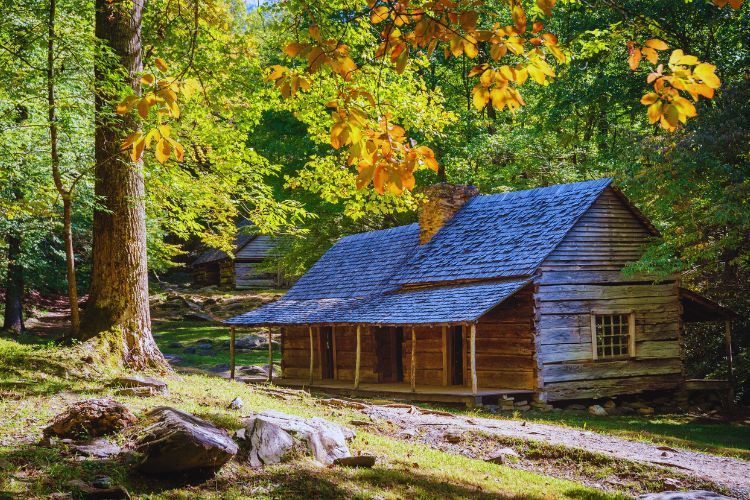
Image by zrfphoto from Getty Images via Canva
Besides its natural beauty, the Cove is also a bit of a museum. The first permanent white settlers entered the 6,000-acre valley in the early 1800s.
By this time, the Native American inhabitants (mostly Cherokee) were being relocated to the Oklahoma territory in what became known as the Trail of Tears.
At the height of European settlement, there were as many as 130 families. However, in a bit of irony, the last settler left in 1937 through eminent domain as the park came to fruition.
Today, there’s a working gristmill, numerous cabins and barns, and three churches from the early 1800s open for exploration that remind us of those long-ago settlers and the lives they led.
The first home we hiked to was the John Oliver cabin. Built in the 1850s of roughhewn logs, it is a single dark room with a loft straight out of Daniel Boone. It is difficult to believe a family of 10 was raised in it.
J. D. Mc Campbell, a blacksmith and carpenter, built our next stop. In 1902, he constructed a church for the Methodist congregation in 115 days for $115. The morning dew glistened on the headstones marking century-old names.
Watch For Wildlife
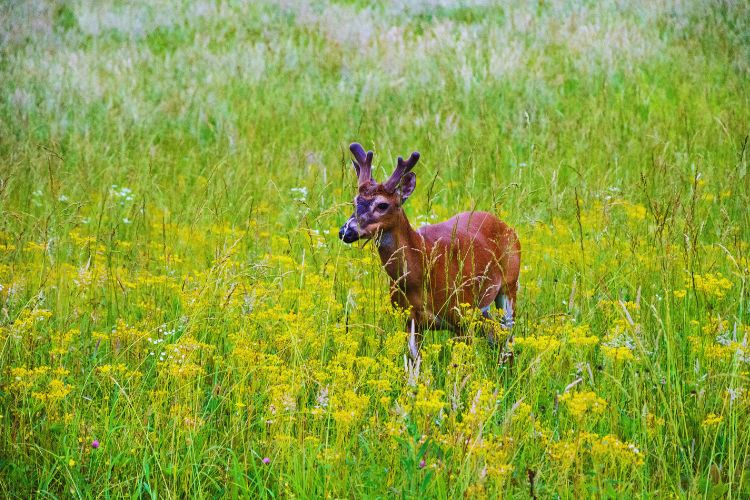
Image by zrfphoto from Getty Images via Canva
We found ourselves constantly on the lookout for sights, but the next one was a little unexpected. As we walked towards another cabin, the young woman ahead of us gave out a startled yelp and pointed to what she referred to as an Anaconda.
Slithering across our path was a medium-sized copperhead snake. After briefly eyeing us, he went on his merry way into the brush. I chose not to follow.
Cades Cove is home to a wealth of animals throughout the year. Besides our brief encounters with bears and a snake, we came across several deer, many of them yearlings.
One, in a moment of playfulness, galloped by us with his tongue lolling out of his mouth without a care.
A coyote and the usual array of squirrels and chipmunks were also seen. By far the most numerous were the flocks of wild turkeys. Seemingly not at all bothered by the upcoming Thanksgiving holiday, they would strut right by us seeking some morsel in the grass.
We pulled over at the Cable Mill Historic Area, located near the halfway point. In addition to using the facilities, we explored several of the buildings, which represent life as it was a century or more ago.
One of the more interesting ones was the grist mill, which was built in the early 1870s and is still functioning. We left with a bag of fresh ground wheat flour.
The Little River Road
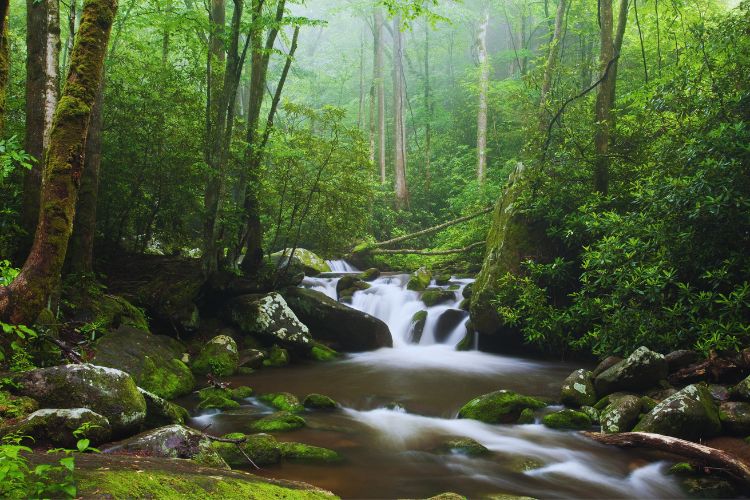
The forested hills of Great Smoky Mountains National Park span the southern Appalachians, extending from Tennessee to North Carolina.
At over 500,000 acres, there was no way we could experience anything but a small part of the great park. So, on this day, we decided to continue to the highest peak in the park, Clingmans Dome.
It’s roughly 50 miles from the Cove to the Dome, which under normal circumstances might take an hour, but driving through the Park is not normal.
The Little River Road curves and winds its way over an old railroad bed between the Cove and the Sugarlands Visitor Center near Gatlinburg for roughly 20 miles, following the Little River.
Remarkable scenery awaited us, with several waterfalls and turn-offs. We stopped at “The Sinks,” where the crystal clear river cascaded down a 15-ft. waterfall, tumbling over huge boulders.
There, we met and briefly spoke with a couple from Georgia who stated that this was their third trip to the park this year.
Even after Labor Day, the park is still heavily visited. We found parking difficult at several of the popular trails and overlooks. And, of course, we had to accept that achieving posted speed limits was seldom going to happen as we negotiated the painfully slow-moving traffic. The upside was that it gave us more time to take in the surroundings.
Best Accomodations Near the Great Smoky Mountains
Sugarlands Visitor Center
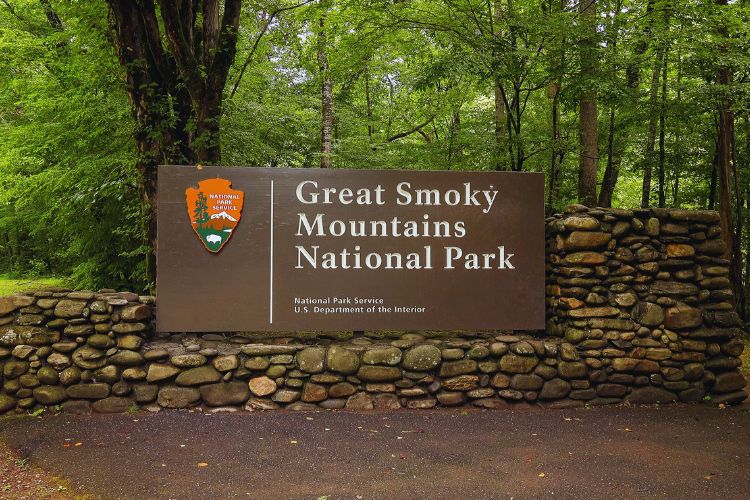
Midway to our destination, we stopped at the Sugarlands Visitors Center. With exhibits and a free film about Great Smoky Mountains National Park, it’s an ideal introduction to the park.
As Kathy had her National Park passport stamped, I asked the ranger at the Information desk how much further to Clingmans Dome it was.
“I wouldn’t go,” he replied, pointing to the live-feed screen on his desk. The top of the mountain was completely socked in by clouds. “They’re calling for thunderstorms,” he added.
It was our only day available, so we threw caution to the wind and headed for Newfound Gap and the Dome.
Driving Newfound Gap to the Highest Peak in the Park
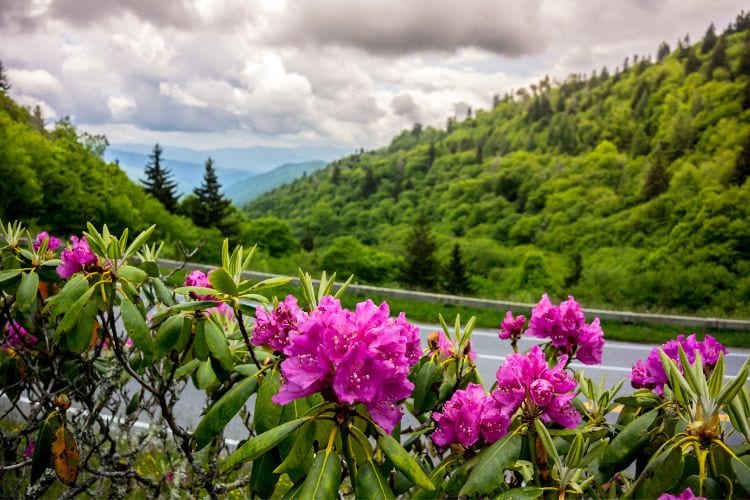
The drive itself is worth it. Bracketed by great swaths of towering hardwood forests, the road took us ever upwards with gorgeous views of Mount LeConte, the 3rd highest peak, the Chimney Tops with their bare rock summit and through a tunnel that loops up and over itself to ease the steep ascent.
When we reached Newfound Gap, we encountered the border of Tennessee and North Carolina. The Appalachian Trail, which runs nearly 2,200 miles from Maine to Georgia, also intersects here. At an elevation of 5,046 feet, Newfound Gap is the lowest drivable pass through the Smokies.
On this site in 1940, President Franklin Roosevelt formally dedicated the park at the Rockefeller Memorial, constructed by the Civilian Conservation Corps to honor the Rockefeller family for its $5 million donation to help establish the park.
Just south of Newfound Gap, the seven-mile Clingmans Dome Road climbs to within 0.5 miles of Clingmans Dome, the highest peak in the Smokies at 6,643′. As we ascended to the top, we were rewarded with blue skies emerging from dissipating grey clouds.
From the large parking area at the end of the road, a trail climbs steeply to the top of “Ol Smokey”
A Worthwhile Steep Climb

Image by Carson Albanese from Getty Images via Canva
The half-mile trail to the summit of Clingmans Dome is paved but very steep. During the short hike, you will gain 332 feet, which makes the climb gradient almost 13%. There are benches throughout the hike in case you need to stop for a minute to catch your breath.
After a stop or two ourselves, we reached the summit, where we were greeted by a massive concrete tower. The 45-foot-high observation tower has a spiraling 375-foot-long ramp that carried us high above the forest to the top.
The rigorous climb was well worth it. The 360-degree panoramic views of the surrounding mountains and spruce forests are marvelous. We could easily see Pigeon Forge, 15 miles away and beyond.
The descent was far easier. Afterwards, we sat with our legs dangling over the truck’s tail-gate as we enjoyed a late and well-earned lunch.
As wisps of clouds floated by, I watched a broad-winged hawk lazily ride the thermals as he eyed the valley far below. The view was amazing.
If you go:
The Great Smoky Mountains National Park runs along the ridges of the Smoky Mountains on the border of Tennessee and North Carolina. It is the most visited park in the United States, receiving more than 14.1 million visitors in 2021. This is more than twice the number of people who visit the Grand Canyon, making it the most popular national park in the US.
The Great Smoky Mountains National Park covers over 522,000 acres and has two main entrances: one in Cherokee, NC, and another in Gatlinburg, TN.
The park is open year-round, though some roadways close in the winter.
The park is admission-free; however, there is a fee to park for more than 15 minutes—$5 for one day, $15 for a week or $40 for the year.
More Info:
Inspire your next adventure with our articles below:
Want to discover more hidden gems and helpful travel tips? Join our free newsletter for the latest travel secrets and travel articles.
We are reader-supported and may earn a commission on purchases made through links in this article.

